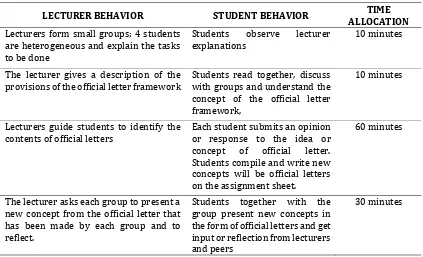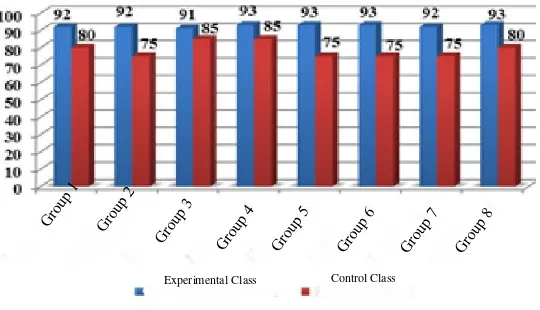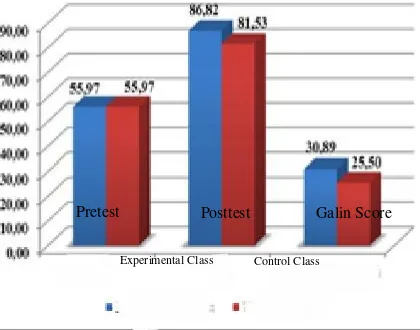Use of Learning Cooperative Integrated Reading and Composition
to the Learning Achievement Indonesian Languange
Correspondence in Study Programs of Office Administration
Brillian Rosy
Faculty of Economics, Universitas Negeri Surabaya, Indonesia Email : brillianrosy@unesa.ac.id
Abstract: This research aims to determine the effect of the CIRC learning model on learning achievement in the Indonesian Language Correspondence course material for writing official letters. This type of research is experimental form of nonequivalent control group design. The subject of the study was all students of UNESA 2016 Office Administration Education Study Program totaling 88 students in which the experimental class was determined as class A and the control class was class B. In the learning control class used the direct instruction model, while the experimental class was treated using the CIRC model. The research instrument uses tests (pretest, posttest, and assignments to make official letters). The results showed that there were significant differences when comparing the average value of the control class with the experimental class, namely the cooperative reading and composition cooperative learning model had a significant effect on student achievement.
Keywords: CIRC, learning achievement, Indonesian language correspondence
INTRODUCTION
One of the important roles of education in human life is the process of developing knowledge and character building for the better. Early education is provided by the family environment and after that is supported by the learning process by an educator to students in the form of learning interactions or knowledge transformation. Learning requires conducive conditions, creating two-way communication between educators and students in teaching and learning activities so that the desired learning objectives are achieved (Perisya, Zuzano, & Amelia, 2015: 2). Students' understanding of a science provided by educators is a goal of learning in order to obtain the desired learning achievement. According to Slameto (2010: 54), "there can be two influences on the results, namely internal and external factors". The learning model is one of several external factors that can have a major influence on the learning outcomes of students who will be taught (Sari and Maimunah, 2017: 31).
As a result of the preliminary study, the Indonesian Language Correspondence course was a character in the UNESA Office Administration Education Study Program. One of the material contained in the Indonesian Language Correspondence course is the basic competency to make an Office Letter. An official letter is a written communication facility in the form of a letter that has an official nature aiming for official needs made by government agencies or private or companies. The making and handling of official letters is one of the tasks of the administration department. Therefore, graduates of the UNESA Office Administration Study Program are required to have the competence to think
creatively in the art of writing, especially writing official letters to support when entering the workforce. Everyone has the ability of creativity, but the level varies depending on how the person can process to find new ideas or concepts. Therefore, Indonesian language correspondence learning should lead to an increase in creative mindset so that graduates are able to adapt to meet the desires of the workforce, society and the country (Munandar, 2012).
Based on the results of observation, in the learning process the material made official letters in the 2016 class of UNESA Office Administration Education Study Program is learning to use the direct instruction model with the lecture method, discussion and assignment. However, the learning method does not make students think creatively because students are only given the task to copy letters that have been explained by lecturers and aired with power point slides. Lecturers still dominate learning, and become centers of learning (Suherman, 2003). This makes students less trained in developing the ability to think creatively. If you look at the value of the UTS (Middle Semester Examination) it looks less than optimal. Class A students of 2016 class of 44 students, 80% still get B grades (interval grades 70-75) and 2016 students class B as many as 41 students 68% also still get B scores (intervals 70-75).
Based on Law No. 20 of 2003 concerning the National Education System, an educator has the task of creating meaningful, creative, fun, dynamic and dialogical learning. Creating learning mentioned above requires the existence of cooperative learning models in order to train students to respect the opinions of others in the form of groups in completing tasks or a problem of Suherman (2003). According to Slavin (2005), "cooperative learning refers to various kinds of teaching methods where students work in small groups to help each other in learning the subject matter. In cooperative classes, students are expected to be able to help each other, discuss and argue with each other, to hone the knowledge they master at that time and close the gap in their respective understandings. "
Cooperative learning models are of many types, but what is right for language subjects is the CIRC learning model. The CIRC learning model is aimed specifically at learning to read questions in the form of notes or descriptions, then find the main ideas or themes (creative thinking) in an integrated manner. Based on Suyitno (2005), "improving the learning outcomes of students especially in solving questions in the form of descriptions is one of the advantages of a cooperative learning model, namely CIRC". CIRC learning method consists of several steps, namely: 1) Formation of groups of 4-5 students (heterogeneous abilities); 2) Lecturers provide a description of the provisions of the official letter framework; 3) students work together to read, find ideas or concepts of official letters, share their opinions or responses to ideas or concepts of official letters that have been submitted by each member and then write in the resulting sheet of paper, 4) presentation; and 5) joint reflection between lecturers and students (Suyatno, 2009).
Gupta & Ahuja (2014) entitled "Cooperative Integrated Reading Composition (CIRC); Impact On Reading Comprehension Achievement In English Among Seventh Graders ". The result is that the CIRC learning model has a significant difference in the achievement of significant reading and writing comprehension between the control classes compared to the class given treatment (experiment with the CIRC model) for the seventh grade students. Based on what has been explained, the researchers are interested in researching an experimental study with the title "Cooperative Integrated Reading and Composition Learning Model; Affecting the Achievement of Learning Indonesian Correspondence Courses ". The aim of the study was to determine the effect of CIRC learning model on learning achievement in the Indonesian Language Correspondence subject, the material was to write an official letter from the 2016 class students of UNESA Office Administration Education Study Program.
METHOD
This type of research is experimental form of nonequivalent control group design. The subject of the research was all the 2016 UNESA Office Administration Education Study Program students where the experimental class was determined to be class A of 44 students and the control class was class B of 44 students. In the learning control class uses direct instruction model, while the experimental class is treated using the CIRC model. The research instrument uses tests (pretest, posttest, and assignments to make official letters) as well as observation sheets of student activities. In this study the independent variable is the influence of the CIRC learning model, while the dependent variable is the learning achievement of the Indonesian Language Correspondence subject in Writing Service Letter. Data collection through documentation, tests and observation methods. Analysis of this research data with homogeneity test, normality test, gain score analysis and t (hypothesis) test.
Table 1 Research Framework Design
O1 X O2
O3 - O4
Explanation:
O1 and O3 = Pretest
O2 and O4 = Posttest
X = Experimental class with the CIRC learning model
RESULT & DISCUSSION
Result
experimental class given treatment with learning using the CIRC learning model. The learning process in the experimental class refers to the method of cooperative learning (student centered) in which students are expected to be more active and the lecturer is only a facilitator. The learning process in the experimental class (CIRC learning model) is as follows:
Table 2. Syntax of the CIRC Learning Model in the Experiment Class
LECTURER BEHAVIOR STUDENT BEHAVIOR TIME
ALLOCATION Lecturers form small groups; 4 students
are heterogeneous and explain the tasks to be done
Students read together, discuss with groups and understand the
The lecturer asks each group to present a new concept from the official letter that has been made by each group and to reflect.
Students together with the group present new concepts in the form of official letters and get input or reflection from lecturers and peers
30 minutes
When the learning process runs, both in the control class and in the experimental class observations of student activities with the following results:
Figure 1. Observation Results of Control Class Student Activities.
Figure 2. Observation Activities of Student Experiment Class Activities
The results of observations of student activities revealed that the CIRC learning model when applied to the experimental class was higher than the direct instruction class of the control class activity on the material of writing official letters. Activities in the control class are considered passive and unfavorable because during the discussion only a few students were active. While others are silent not participating because it does not master the material. While the activities of students in the experimental class are more active and both seen from the discussion activities, collaborating, respecting the opinions of others, mastering the material, and when communicating or presenting tasks.
In addition to observation of activities, an assessment task assignment analysis was also carried out in which the results of the evaluation of the control class assignments were lower than those of the experimental class assignments. The average value of the assignment of the experimental class is 92.24 with the CIRC learning model and the average value of the assignment for the direct instruction model is 78.75. The results of the assignment assessment can be seen in the following figure:
Figure 3. Assessment of Tasks to Make Service Letters
Liveliness
Presentation
Respect to others peoples opinian Mastery of the material
Verbal communication Collaboration
Pretest and Posttest results show a significant difference, where the average value of the control class in terms of the psychomotor and cognitive domains is lower than the experimental class. The difference in the results of the Pretest and Posttest can be seen as follows:
Table 3. Results of Experiment Classes
Learning Outcomes
Pretest Posttest
Cognitive Pyschomotor Cognitive Pyschomotor
Highest Score 65 85 100 100
Lowest Score 20 50 80 80
Average 41,48 70,45 86,59 87,05
Table 4. Results of Control Classes
Learning Outcomes
Pretest Posttest
Cognitive Pyschomotor Cognitive Pyschomotor
Highest Score 70 75 100 85
Lowest Score 20 40 70 60
Average 50,57 61,36 85 78,07
So it can be concluded that the CIRC learning model has a significant effect on the assessment in terms of the psychomotor and cognitive domains in the official writing letter. So that the results look more significant, the results of the pretest and posttest are recapitulated and the gain score data is obtained (the difference between the pretest and posttest results) between the control class compared to the experimental class are:
Figure 4. Results of pretest recapitulation, posttest and gain score
Looking at the recapitulation data, it can be concluded that the application of the CIRC learning model to the experimental class has a significant effect on learning
Pretest Posttest Galin Score
achievement when compared to the control class. This is evidenced in the average posttest experimental class of 86.82 higher than the control class where the posttest average is 81.53.
Based on the results of the posttest, using the t test (hypothesis) then t count is 5,004 with a significance level of 000 (0,00). While the ttable value is seen using the
t distribution table with a confidence level of 95% (α = 5%), the degree of freedom
(df) is 86, then the table is 1.987. Referring to the results above, it was concluded that Ha was accepted because the t-test <0.05 was 0.00 <0.05 and tcount> ttable was 5.004> 1.987. While the results of the gain score analysis or the difference between the pretest and posttest scores, the result of the tcount is 3.946 the significance level, 000 (0.00). Whereas the value of t table is 1.987 with a significance level of 0.05. So it can be concluded that H0 is rejected and Ha is accepted because the t-test is <0.05 which is 0.00 <0.05 and t count> t table is 3.946> 1.987 which means that the cooperative reading and composition cooperative learning model has a significant effect on the achievement of learning subjects Indonesian language correspondence material wrote the official letter of students of the 2016 class of the UNESA office administration education program.
Discussion
The cooperative reading and composition (CIRC) cooperative learning model helps to increase student activities by reading a description form in the form of official letters, after reading and then discussing with the group to find ideas or core letters, writing down the core of the letter on the assignment sheet. present and response from colleagues and lecturers. This is consistent with the CIRC learning method which consists of several steps, namely: 1) Formation of groups of 4-5 students (heterogeneous abilities); 2) Lecturers provide a description of the provisions of the official letter framework; 3) students work together to read, find ideas or concepts of official letters, share opinions or responses to ideas or concepts of official letters that each member has submitted and then write on the resulting sheet of paper, (4) presentation; and (5) joint reflection between lecturers and students (Suyatno, 2009).
The results obtained through observing student activities revealed that, the CIRC cooperative learning model applied to the experimental class had an impact on increasing student activity when compared to the results of the observation in the control class which had lower results in the material of writing official letters. This is reinforced by the opinion of Slavin (2005: 4), "Cooperative learning refers to various kinds of teaching methods where students work in small groups to help each other in learning the subject matter. In cooperative classes, students are expected to be able to help each other, discuss and argue with each other, to hone the knowledge they master at that time and close the gap in their respective understandings. "
member in the group must think critically about finding ideas, understanding the concept of official letters and completing the task of writing assignment letters, thus forming an integrated understanding of learning experience and experience (Marpuah et al, 2015).
Pretest and Posttest results show a significant difference, where the average control class results are lower when compared to the experimental class in terms of the psychomotor and cognitive domains. The same thing is shown by the results of the data recapitulation where it can be concluded that the experimental class with the application of the CIRC learning model has a significant change in learning achievement compared to the control class. This is evidenced in the average posttest experimental class of 86.82 higher than the control class where the posttest average is 81.53. Overall it was concluded that Ha was accepted because the t-test <0.05 was 0.00 <0.05 and t count> t table was 5.004> 1.987. Whereas the value of t table is 1.987 with a significance level of 0.05. So it can be concluded that H0 is rejected and Ha is accepted because the t-test is <0.05 which is 0.00 <0.05 and t count> t table is 3.946> 1.987 which means that the cooperative reading and composition cooperative learning model has a significant effect on the achievement of learning subjects Indonesian language correspondence material wrote the official letter of students of the 2016 class of the UNESA office administration education program. The results of this study are supported by previous research by Gupta & Ahuja (2014) entitled "Cooperative Integrated Reading Composition (CIRC); Impact On Reading Comprehension Achievement In English Among Seventh Graders ". The result is that the CIRC learning model has a significant difference in the achievement of significant reading and writing comprehension between the control classes compared to the class given treatment (experiment with the CIRC model) for the seventh grade students.
CONCLUSION & SUGGESTIONS
REFERENCES
Gupta, Madhu and Ahuja, Jyoti. 2014. “Cooperative Integrated Reading Composition
(CIRC) : Impact On Reading Comprehension Achievement In English Among
Seventh Graders”. IMPACT : International Journal of Research in Humanities,
Arts and Literature. Vol. 2 (5) : pp 37-46.
Marpuah, Siti, Rahayuningsih, Margareta, dan Sri Sukaesih. 2015. “Efektivitas Model
Pembelajaran Cooperative Integrated Reading and Composition (CIRC) dengan
Mind Mapping”. Unnes Journal of Biology Education. Vol. 4 (3) : page.
244-250.
Perisya, F., Zuzano, F., & Amelia, P. (2015). Penerapan Model Pembelajaran Kooperatif dengan Teknik Round Robin Pembelajaran Matematika Siswa Kelas
VIII MTsN Model Padang. Jurnal Keguruan Dan Ilmu Pendidikan, 6(1), 1–11.
Sari, N. T. I., & Maimunah, S. (2017). Pengaruh Metode Pembelajaran Kooperatif Tipe Round Robin Terhadap Prestasi Mata Pelajaran Bahasa Indonesia Siswa SMA.


